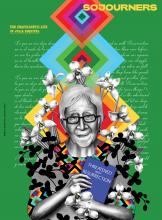AMID THE NOISE of our news cycles, there are the occasional stories that become part of our personal journeys. Sometimes, we only need a word or phrase to bring them back with full force, like “the Holocaust” or “9/11.” Sometimes, it’s just the name of a city. Pittsburgh. El Paso.
For me, Pittsburgh now conjures up images of a deliberate slaughter of Jews in their synagogue because of their religion—which is also my religion. According to their attacker, it was also because they supported the Hebrew Immigrant Aid Society, which resettles refugees, including people from Africa, Eurasia, Latin America, and the Middle East.
Similarly, El Paso reminds me of my grandmother. She was an immigrant who escaped her Jewish village after her left arm was badly burned—and forever scarred—during a Cossack attack. In El Paso, Hispanic immigrants were also deliberate targets, as another mass murderer went to Walmart.
Each of these tragic events is personal for me, and each is horrifying in its own right. But they are not isolated phenomena. The anti-Semitic and anti-immigrant sentiments on which they were built are intertwined.
Both reflect long-standing tribalism rooted in hate, and both are being exacerbated by rapid societal change, globalization, and emerging transnational networks proliferating white supremacist ideologies. These realities give us Pittsburgh, El Paso, Jersey City, Poway, and countless other mass murders—while exponentially metastasizing hate, the dehumanization of “others,” and violence.
Intertwined xenophobia
ANTI-SEMITISM AND XENOPHOBIA have existed throughout history and, most certainly, throughout the American experience. Grounded in dehumanizing stereotypes and malicious conspiracy theories, anti-Semitism operated alongside xenophobic mindsets that forced Jews into ghettos or sought to push them out of communities altogether, as the unwelcome stranger.
Similarly, immigrants to the U.S. and migrants worldwide have repeatedly been othered and ostracized, often prevented from freely following their faiths and being viewed as lesser than those in so-called civilized society. Consider the Irish who emigrated during the potato famine. As immigrant Catholics they faced violence and the emergence of anti-immigrant groups dedicated to “returning” the country to their homogeneous vision of the U.S.—such as the Order of the Star-Spangled Banner, which was committed to preserving a Protestant America. In a similar way that Jews have historically been labeled, the Irish were stereotyped as undesirable and dangerous. Today, we hear the same drumbeat, this time toward Muslims and other groups seeking to emigrate across borders, people who are called invaders and terrorists.
Read the Full Article

